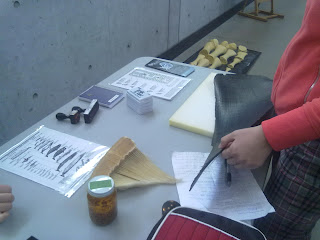On the 10th of december 2010, my class and I went on a field trip to UBC beauty museum. At 10:30am, we gathered at the CK Choi building to the northwest of the campus. Not only did the building act as a gathering point for us, but we also investigated its exrtraordinary sewage disposal system. In addition, we also took some photos, both for fun and educational purpose
On the way to the beauty museum, we saw a carriage with a rocket set at the back. However, the most attractive scenario was a historical gothic style building with a clock tower that stands in front of it. I had no clue what it is used for but simply attracted by its symetrical beauty and the height of the tower.
The first thing we saw was the skeleton of a bluw whale found in the PEI, donated by a professor. the skeleton was as hughe as a translink long-type bus and it contains about 180 bones. However, the whale was actually a mutant with 31 limbs as the description metioned. There was a story behind this whale skeletion. The whale was found on the beach of PEI at the first place, it was then left for decades until sciencetists found it. When the scientists dug it out, although the meat was rotten, surprisingly, most of its body was preserved by the sand and it stinked seriously. Another remarkable fact was that one of its pectoral fin was missing, whh was later found taken by a farmer for the use of decoration near his primitive fire heater. The farmer, keeping the fin for years were hesitating to donate the fin until the beauty museum offered him to the opening of the museum, providing all the travelling fees. Therefore, when we carefully observed the pectoral fins, we could find that one of it was yellowish in colour.
Afterwards, we walked around the museum, endeavored to complete the assignment....
Some students from UBC was finding some samples of organisms. The smell stinked when they opened the container.
A "secret" lab is situated at the end of the hallway, which was pretty hard to find, I did not see anyone walking in except myself and daniel whang....
Dinosaur foot bone
*My group mates and I walking around in search for the answers*


















































